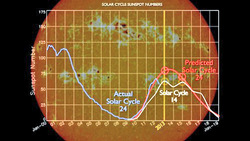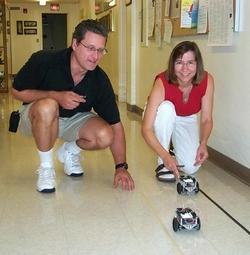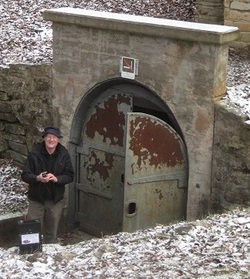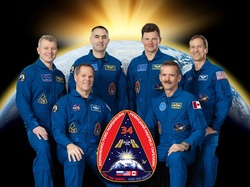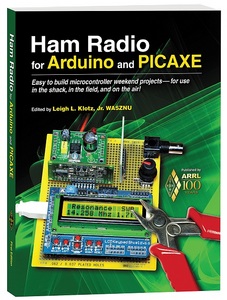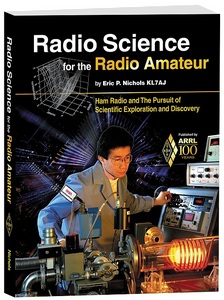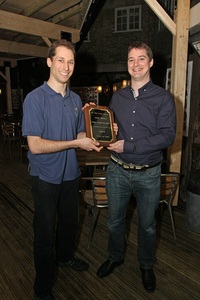 March 14, 2013 John E. Ross, KD8IDJ, Editor
| |||||||||||
+ Available on ARRL Audio News. There will be no ARRL Audio News on Thursday, March 21. The ARRL Letter will be distributed on its regular schedule that day. The ARRL Audio News will return March 28. + Solar Cycle 24 May Have "Double Peaks," Says NASA Solar Physicist
According to NASA, the current solar cycle -- Solar Cycle 24 -- should hit its "solar max" sometime in this year, but so far, solar activity has been relatively low. According to an article by NASA's Dr Tony Phillips, this period of quiet has led some observers to wonder if forecasters missed the mark. But solar physicist Dean Pesnell of NASA's Goddard Space Flight Center has a different explanation: "This is solar maximum. But it looks different from what we expected because it is double peaked." Pesnell noted similarities between the current cycle and Solar Cycle 14, which happened between February 1902 and August 1913 and experienced a double peak. If the two cycles are in fact twins, he said that "it would mean one peak in late 2013 and another in 2015." Read more here. + Amateur Radio in the Classroom: DARA to Provide Financial Support for Advanced Teachers Institute Session
The ARRL is preparing to present the 2013 sessions of its popular Teachers Institute on Wireless Technology this summer. For the fourth year in a row, the Dayton Amateur Radio Association (DARA) will provide financial support for the advanced session of the Teachers Institute (TI-2). The TI-2 session -- Remote Sensing and Data Gathering -- will be held July 22-25 at DARA's new classroom facility at their clubhouse in Dayton, Ohio. In addition, there will be two basic Teachers Institute sessions (TI-1) this summer: One at ARRL Headquarters in Newington, Connecticut (July 8-11) and one at Parallax, Inc in Rocklin, California (July 15-18). Read more here. + Bob Bruninga, WB4APR, Takes APRS Underground
Bob Bruninga, WB4APR, led a group of radio amateurs earlier this month to Mammoth Cave -- the world's longest known cave system -- at Mammoth Cave National Park in Kentucky to test how the Automatic Packet Reporting System (APRS) can be used as a means to extend radio communications underground. "When used underground, VHF and UHF radios can only work within a few hundred feet of each other and only when in the line of sight of another radio," Bruninga explained. "This makes routine use of these radios of little value when underground; however, when APRS radios act as packet digipeaters, these few hundreds of feet can be extended by an order of magnitude." Bruninga, a senior research engineer at the US Naval Academy, developed APRS as a global, on-air protocol for supporting handheld position reporting and text messaging via VHF radio. Read more here. + Amateur Radio in Space: Astronauts Return to Earth from ISS; Watch Live on NASA TV
After spending 143 days in space, Expedition 34 Commander Kevin Ford, KF5GPP, Russian Soyuz Commander Oleg Novitskiy and Russian Flight Engineer Evgeny Tarelkin (both of the Russian Federal Space Agency) will begin their voyage home to Earth on Thursday, March 14, marking the end of Expedition 34 on board the International Space Station (ISS). The trio will undock their Soyuz spacecraft at 8:30 PM EDT (0030 UTC on Friday, March 15) for the flight home. They are scheduled to arrive in Arkalyk, Kazakhstan almost four hours later at 11:57 PM EDT (0357 UTC on Friday, March 15). NASA will televise the farewell ceremony, as well as the undocking of the Soyuz craft, its launch and its landing in Kazakhstan live on NASA TV. Read more here. Two New Books for Your Amateur Radio Library The ARRL has released two new books: Ham Radio for Arduino and PICAXE edited by Leigh L. Klotz Jr, WA5ZNU, and Radio Science for the Radio Amateur by Eric Nichols, KL7AJ. Ham Radio for Arduino and PICAXE
Microcontroller technology has exploded in popularity among ham radio operators. The new generation of single-board microcontrollers is easier than ever to use, bringing together hardware and software for project building that radio amateurs can easily dive into. With inexpensive microcontroller platforms -- such as the popular open-source Arduino board -- readily available parts, components and accessory boards, you can create beacon transmitters, keyers, antenna position control, RTTY and digital mode decoders, waterfall displays and more. Editor Leigh L. Klotz Jr, WA5ZNU, has assembled this first edition of Ham Radio for Arduino and PICAXE to help introduce radio amateurs to the fun and rewards of experimenting with microcontrollers. Klotz and other contributors have designed projects that will enhance your ham radio station and operating capabilities, or you can use these projects as a launch pad for creating your own projects. Radio Science for the Radio Amateur
In Radio Science for the Radio Amateur, Eric Nichols, KL7AJ, explores and explains the often profound differences between science and technology, dispelling the notion that we know all there is to know about radio. Using a fresh, playful approach, Nichols guides readers through some of the most fascinating "nooks and crannies" of the radio universe. Along the way, you'll find out how solving long-standing mysteries of radio -- of which there are still many -- doesn't require expensive hardware, but merely a scientific mindset and attention to detail. These new publications are available from your ARRL Dealer or the ARRL Store. Ham Radio for Arduino and PICAXE (ARRL Order No. 3244), ISBN 978-0-87259-324-4, $34.95 retail, special ARRL Member Price $29.95, plus shipping; Radio Science for the Radio Amateur (ARRL Order No. 3381), ISBN 978-0-87259-338-1, $27.95 retail, special ARRL Member Price $24.95, plus shipping. + W1AW Announces 2013 Spring Operating Schedule With the switch from Standard Time to Daylight Saving Time this past weekend, W1AW Station Manager Joe Carcia, NJ1Q, has updated the W1AW operating schedule to reflect the change. Your local standard times have not changed, but the UTC times they reference have. Read more here. + ARRL, Microsoft Resolve E-mail Blockage
After more than 20,000 ARRL members had their arrl.net and arrl.org e-mails blocked by Microsoft, the issue has been resolved. According to ARRL Information Technology Manager Michael Keane, K1MK, Microsoft told the ARRL that the mail blockage from ARRL servers to Microsoft domains (including msn.com, hotmail.com, live.com and outlook.com) was mitigated as of Sunday, March 10. Solar Update
Tad Cook, K7RA, reports: Solar indicators were mixed this week, with the average daily sunspot number down 8.4 points to 84.9, while the average daily solar flux rose 5.9 points to 118.5. Geomagnetic indices were much quieter, with the average planetary A index down 4.7 points to 4.4 and the average mid-latitude A index down 5 points to 3.9. The predicted solar flux for March 14-15 is 120, then 115 on March 16-17, 110 on March 18-20, 105 on March 21, 95 on March 22-24, 100 on March 25-26, 105 on March 27, 110 on March 28-31, 115 on April 1-3, and then peaking around 120 on April 4-11. The predicted planetary A index on March 14-16 is 8, 20 and 12, indicating more geomagnetic activity similar to March 1-2. The predicted planetary A index is 5 on March 17-20, 8 on March 21, 5 on March 22-27, 18 and 10 on March 28-29, and back down to 5 on March 30-April 16. Look for more on the ARRL website on Friday, March 15. For more information concerning radio propagation, visit the ARRL Technical Information Service Propagation page. + US Postal Service Introduces Global Forever Stamp
In addition to an increase in postal rates in January 2013, the US Postal Service introduced a new Global Forever First-Class Mail International stamp. Priced at $1.10 each and offered in a pane of 20, the new stamp offers a single price for any First-Class Mail International 1-ounce letter to any country in the world, as well as 2-ounce letters to Canada. The stamp is available online, at post offices in the US or by calling 1-800-782-6724. -- Thanks to ARRL Oklahoma Section Manager Kevin O'Dell, N0IRW, for the information. British Ham Receives 2012 Cass Award
Rob Chipperfield, M0VFC/ZD9UW, of Cambridge, England, received the 2012 Single-Operator Cass Award. The Cass Award -- a monetary award of $1000 -- is offered as an incentive to encourage DXpedition operating excellence, and to encourage DXpeditions to maximize the number of different DXers worked. Chipperfield received the award for working 3362 unique stations over his four-day DXpedition to Tristan da Cunha in October 2012. In order to qualify for the award, he had to use radio transmitting and receiving equipment that he brought to Tristan da Cunha, as well as antennas that he either brought to Tristan da Cunha or that he constructed from local materials. The Cass Award is named in honor of Hugh "Cass" Cassidy, WA6AUD (SK), who published the West Coast DX Bulletin from 1968-1979. This Week in Radiosport This week:
Next week:
All dates, unless otherwise stated, are UTC. See the ARRL Contest Branch page, the ARRL Contest Update and the WA7BNM Contest Calendar for more information. Looking for a Special Event station? Be sure to check out the ARRL Special Event Stations web page. Upcoming ARRL Section, State and Division Conventions and Events
To find a convention or hamfest near you, click here. ARRL -- Your One-Stop Resource for Amateur Radio News and Information Join or Renew Today! ARRL membership includes QST, Amateur Radio's most popular and informative journal, delivered to your mailbox each month. Subscribe to NCJ - the National Contest Journal. Published bi-monthly, features articles by top contesters, letters, hints, statistics, scores, NA Sprint and QSO Parties. Subscribe to QEX -- A Forum for Communications Experimenters. Published bi-monthly, features technical articles, construction projects, columns and other items of interest to radio amateurs and communications professionals. Free of charge to ARRL members: Subscribe to the ARES E-Letter (monthly public service and emergency communications news), the ARRL Contest Update (bi-weekly contest newsletter), Division and Section news alerts -- and much more! Find us on Facebook. Follow us on Twitter. ARRL offers a wide array of products to enhance your enjoyment of Amateur Radio. Donate to the fund of your choice -- support programs not funded by member dues! Click here to advertise in this newsletter (subject to space availability). | |||||||||||
